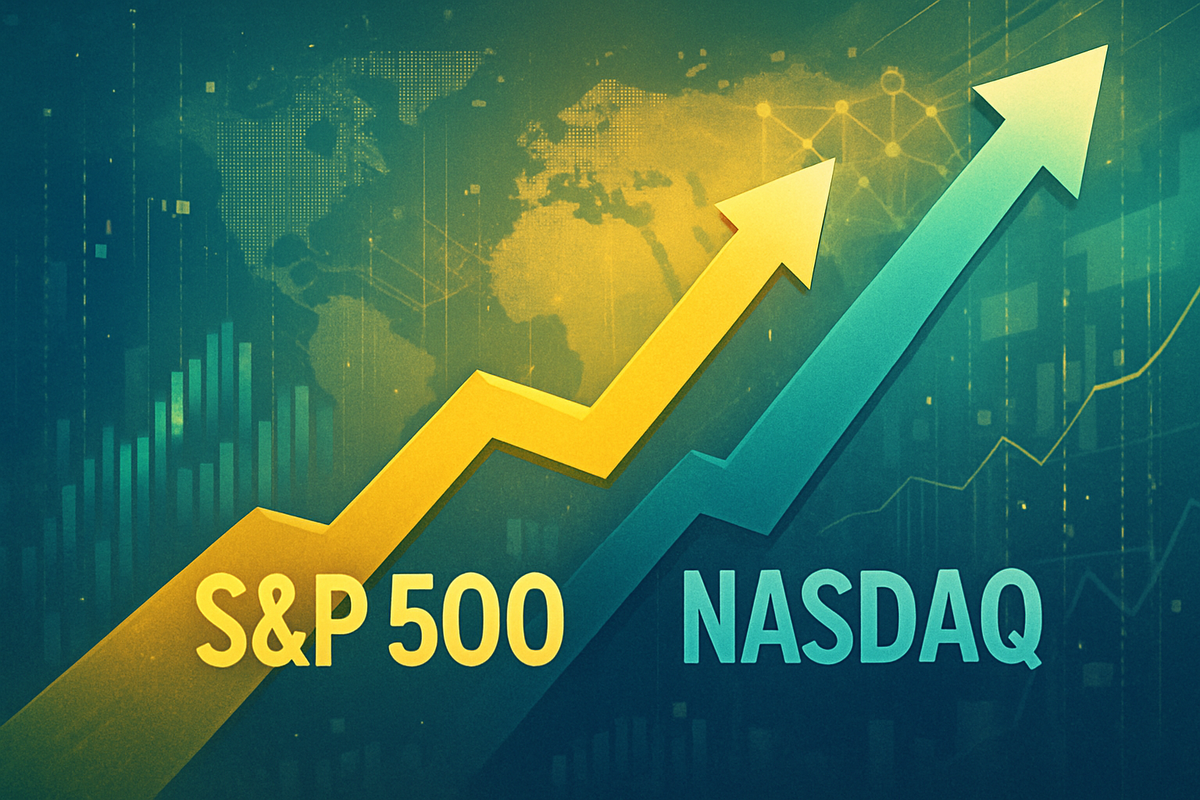
Today, October 7, 2025, the U.S. stock market witnessed a historic milestone as both the S&P 500 and the Nasdaq Composite indices closed at new all-time record highs. This significant achievement underscores a robust market sentiment and reflects an underlying optimism in the economic landscape, sending a powerful signal of confidence to investors worldwide. The surge indicates a broad-based rally, fueled by a confluence of positive economic indicators and strong corporate performances, pushing valuations into uncharted territory and marking a pivotal moment for global financial markets.
A Day of Market Triumph and Optimism
The trading day culminated in a celebratory close, with both benchmark indices shattering previous records. While specific index values are yet to be fully tabulated, the consistent upward momentum throughout the session was undeniable. This remarkable ascent has been attributed to several factors, including sustained corporate earnings growth that has consistently exceeded analyst expectations, a favorable interest rate environment that continues to bolster investment, and a growing sense of stability in global geopolitical affairs. The technology sector, a dominant force within the Nasdaq, played a particularly crucial role, with innovation and robust demand driving many of its constituent companies to new valuation peaks. The S&P 500's broader representation of the U.S. economy suggests that this bullish sentiment is not confined to a single sector but is rather a widespread phenomenon, indicating health across diverse industries. This sustained rally follows a period of measured growth, with market participants increasingly confident in the long-term prospects of the American economy.
Companies Poised for Gains and Potential Scrutiny
In a market environment where major indices are hitting record highs, a diverse array of companies stand to benefit significantly, while others may face increased scrutiny regarding their valuations. Technology giants, particularly those leading in artificial intelligence, cloud computing, and digital transformation, are expected to be primary beneficiaries. Companies like Apple (NASDAQ: AAPL), Microsoft (NASDAQ: MSFT), and Alphabet (NASDAQ: GOOGL), with their strong balance sheets and continuous innovation, often see their stock prices appreciate in such rallies, further solidifying their market dominance.
Beyond tech, companies with strong market positions in sectors benefiting from economic expansion, such as consumer discretionary, industrials, and healthcare, within the S&P 500 are also likely to thrive. For instance, Amazon (NASDAQ: AMZN) could see continued gains from e-commerce and cloud services, while established financial institutions like JPMorgan Chase (NYSE: JPM) might benefit from increased economic activity and lending. However, the elevated market levels could also lead to concerns about overvaluation, particularly for companies with high price-to-earnings ratios or those that have experienced rapid, speculative growth without commensurate fundamental improvements. Investors will be closely watching for signs of profit-taking or shifts in sentiment that could impact these highly valued assets.
Broader Implications and Historical Context
The S&P 500 and Nasdaq reaching record highs on October 7, 2025, carries significant broader implications, signaling a robust and confident financial landscape. This event fits squarely into a trend of increasing digitalization and technological advancement, which has consistently driven market growth over the past decade. The ripple effects are likely to extend across various sectors: increased investor wealth could stimulate consumer spending, while strong corporate valuations might encourage further mergers and acquisitions, fostering consolidation and innovation within industries. Regulatory bodies may also intensify their focus on market stability and potential antitrust concerns, especially within the dominant tech sector, as these companies continue to amass unprecedented market capitalization.
Historically, periods of sustained market highs are often underpinned by strong economic fundamentals, such as low unemployment, manageable inflation, and healthy corporate profits. Comparisons can be drawn to bull markets of the late 1990s or the post-2008 recovery, where technological innovation and global economic expansion fueled prolonged periods of growth. However, history also teaches caution, as such peaks can sometimes precede periods of correction or increased volatility. The current scenario suggests that the market is currently shrugging off potential headwinds, such as ongoing geopolitical tensions or supply chain disruptions, focusing instead on underlying corporate strength and the potential for future innovation-driven growth.
What Comes Next: Navigating the Heights
Looking ahead, the market's record highs present both exciting opportunities and potential challenges. In the short term, the momentum could continue, driven by positive investor sentiment and further inflows of capital, potentially leading to additional gains. However, this elevated state also raises questions about sustainability and the potential for a market correction. Investors will be closely watching upcoming earnings reports for Q4 2025 and Q1 2026, as well as any signals from central banks regarding monetary policy, particularly interest rate adjustments, which could significantly impact market liquidity and investor appetite for risk.
Long-term possibilities include a continued "secular bull market" if technological advancements, particularly in AI and sustainable energy, continue to drive productivity and economic expansion. Companies may need to strategically pivot, focusing on capital efficiency, sustainable growth, and potentially divesting non-core assets to maintain investor confidence at these high valuations. New market opportunities could emerge in nascent industries or disruptive technologies, while existing market leaders might face increased competition from agile startups. Potential scenarios range from a "soft landing" where growth moderates gracefully, to more volatile periods if unexpected economic shocks or policy shifts occur. The key will be adaptability and a keen eye on fundamental economic indicators.
A Market at the Pinnacle: Assessing Future Trajectories
Today's record-breaking close for the S&P 500 and Nasdaq Composite on October 7, 2025, marks a significant chapter in financial history, underscoring a period of profound optimism and robust economic performance. The key takeaway is the market's resilience and its capacity for sustained growth, particularly driven by innovation and strong corporate leadership. Moving forward, the market will likely be characterized by a careful balance between capitalizing on continued growth opportunities and mitigating risks associated with elevated valuations.
Investors should remain vigilant, focusing on company fundamentals, diversification, and a long-term perspective. While the current euphoria is palpable, understanding the underlying drivers of growth and potential vulnerabilities will be crucial. Key indicators to watch in the coming months include inflation data, employment figures, central bank policy statements, and geopolitical developments. The lasting impact of this period of record highs will depend on whether economic growth can continue to justify current valuations, or if the market is poised for a period of consolidation. This content is intended for informational purposes only and is not financial advice.
This content is intended for informational purposes only and is not financial advice.





